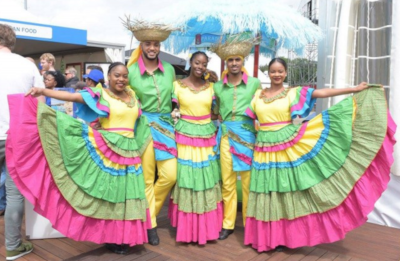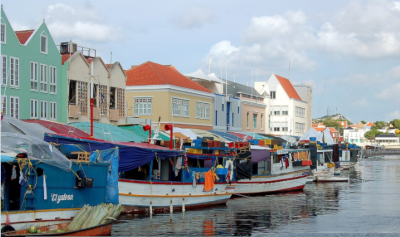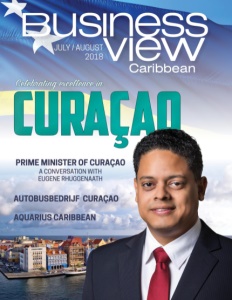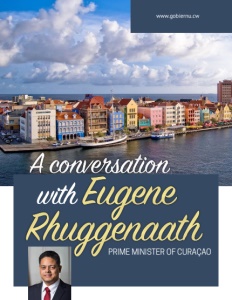A Conversation with Eugene Rhuggenaath
Prime Minister of Curaçao
Business View Magazine interviews Eugene Rhuggenaath, Prime Minister of Curaçao as part of our focus on best practices in Caribbean government.
The Prime Minister of Curaçao is the head of the country’s government. The post was created after the Netherlands Antilles had been dissolved on October 10, 2010 and Curaçao became a country within the Kingdom of the Netherlands. The Prime Minister, together with the Council of Ministers and the Governor of Curaçao, form the executive branch of the government.
Curaçao’s current Prime Minister is Eugene Rhuggenaath, a Curaçaoan politician and party leader of the Partido Alternativa Real (PAR). He was Minister for Economic Development in the Cabinet in 2016, and a member of the Island Council of Curaçao between 2003 and December 2009. He was sworn in on May 29, 2017.
Recently, Business View Magazine spoke with Prime Minister Rhuggenaath about his first year in office and his vision for the country. The following is an edited transcript of that conversation.
BVM: Prime Minister, can you describe what you see as the primary role of the office and how it provides support and governance to the businesses and citizens of Curaçao?
Rhuggenaath: “Since October 10, 2010, when Curaçao attained its country status, there’s been political instability. We’ve had several cabinets and, in certain ministries, there have been too many changes of leadership at the top level. Therefore, one of the most important contributions I want to accomplish is stability and the implementation of our government program to regain the confidence in government and the country, in general. And the way we want to do this is to promote transparency and integrity, but also, myself as Prime Minister, because I do believe in servant leadership, where I act as facilitator for building bridges to business, and working more collaboratively both with government and with the civil society.”
BVM: In a recent article, you said that you have several priorities that you are focused on: the Tourism Master Plan, the investment climate, the development of the harbor and the maritime sector, and the airport. Can you speak about your goals concerning those issues and what accomplishments you have made so far in pursuit of them?
 Rhuggenaath: The airport expansion is about a $35 million investment that is now in the last phases of completion. What is missing there is the development of the areas surrounding the airport, where we have some properties. But together with Curinde, the company managing our economic zone at the airport, and Curaçao Airport Holding, which is the government-owned company that owns the property, I believe we can create synergies that attract business or real estate development related to airport activities. There is a lot of opportunity for growth.
Rhuggenaath: The airport expansion is about a $35 million investment that is now in the last phases of completion. What is missing there is the development of the areas surrounding the airport, where we have some properties. But together with Curinde, the company managing our economic zone at the airport, and Curaçao Airport Holding, which is the government-owned company that owns the property, I believe we can create synergies that attract business or real estate development related to airport activities. There is a lot of opportunity for growth.
“With regards to the harbor, there have been some very positive developments there. The ship repair yard has been partially privatized in the sense that it is being operated by Damen Shipyards, which is a Dutch, multi-national company. A few weeks ago, we received two new floating docks there, expanding the capacity about 35 percent. So that has been a big gain for the shipyard.
“We have several developments under the coordination of the Ports Authority in the downtown area. We have the second mega-pier in operation at the cruise terminal, and three other development projects; one of them is adjacent to the new mega-pier – a mixed-use development, including the transformation of our small baseball stadium, there, into a tourist attraction. Another is a small marina; and on the harbor side of the waterfront, a mixed-use development, including a hotel that we are facilitating with a private investor.
“The Minister of Economic Development is leading the development of a new harbor called Bullenbaai. At this moment, it is an oil terminal. But there, we have a natural deep sea harbor. We are ready, together with stakeholders, to develop a vision document, which is now being translated into a development plan, and we hope to do this with our strategic partner, the Port of Rotterdam.
“The Tourism Master Plan is still in implementation. To put it simply – we need to fill the planes and fill the hotels. But I do believe that we need to focus a little bit more on one of its objectives: to increase investment and make it more attractive to invest. We need to increase the RevPAR, which is the revenue for the average room, to make it more attractive to invest in additional rooms. To do that, I propose a more practical approach, whereby tourism partners focus on the low-hanging fruit. We now have daily service – COPA from Panama, which opens up possibilities of attracting more tourism from the Latin American market. But, the northeast of the U.S. still has a lot of room to grow. We have additional service coming at the end of the year with Jet Blue out of New York, which, I hope, we can expand from other airports.
“The European market has been our staple factor for growth for the last decade or so. But, we do need to move to a more sophisticated tourist. Not that we don’t want the current tourism, of course we do. That has been wonderful for Bed and Breakfast, for apartments, and so on. But, if we want higher tourist spending from the European market, we need tourists to stay in hotels; we need tourists who enjoy a more sophisticated product like a culinary experience, festivals, and so on. I’m speaking of the Dutch market, the German market, and perhaps, where possible, Scandinavia and even down to the south – Spain or Italy. I think we can do a lot more from Europe and blend, as our heritage is, Caribbean, European, and Latin American flavors. I think that’s what makes Curaçao a little bit unique in the neighborhood. I want the blend of tourists to be more representative of this vision.
 “One of the things that I’m happy and proud about, and also a fan of, is the North Sea Jazz Festival, which is coming back in September with top-tier artists after an absence, last year. That has been a staple for us in what used to be a down month. The Festival will be back, and we hope, this time, to stay, because part of the Tourism Master Plan has also been to promote Curaçao as ‘The Stage of the Caribbean,’ where we have different festivals, and different cultural experiences throughout the year, again, attracting the blend of different nationalities coming and mingling with our multi-cultural society.”
“One of the things that I’m happy and proud about, and also a fan of, is the North Sea Jazz Festival, which is coming back in September with top-tier artists after an absence, last year. That has been a staple for us in what used to be a down month. The Festival will be back, and we hope, this time, to stay, because part of the Tourism Master Plan has also been to promote Curaçao as ‘The Stage of the Caribbean,’ where we have different festivals, and different cultural experiences throughout the year, again, attracting the blend of different nationalities coming and mingling with our multi-cultural society.”
BVM: How do you communicate to your own citizens about some of the initiatives that you are hoping see come to fruition, in order to get popular support behind them?
Rhuggenaath: “That is a very good question and it’s a challenge that we are still wrestling with, but it’s very important. And that goes back to my first answer – I want Curaçao to start believing in Curaçao, again. So, it’s moving from a perception of stagnant or minimal growth to having confidence in our future and the role that government can play, moving towards believing in what we have.
“Curaçao has a lot of potential in different sectors but, somehow, we haven’t been able to convert these into opportunities. Traditional communication that may have worked ten years ago – for example holding press conferences, press releases, media appearances – doesn’t work anymore. You need to engage with the community. You have to be out there, talking to stakeholders, being in neighborhoods, communicating at all levels, and also communicating more frequently, which, of course, can be a challenge for a politician, considering how social media is dominating the conversation spectrum. So, we have been doing a lot of Facebook and using social media, but still there’s a lot more that we need to do. And that’s why we have been ramping up both the internal and external communication of everything that the government is doing, because I think that the people are not sufficiently informed of what we’re doing to facilitate development and trying to move the country forward.
“I can give you one concrete example. I’m chairing an inter-ministerial taskforce, consisting of myself, the Minister of Economic Development, the Minister of Urban Planning, and the Minister of Finance, in order to move projects that have been supported by private sector investors in areas like logistics, tourism development, housing, and agriculture and fisheries (because we want to move more towards improving food security through our own cultivation). But there is not a lot being communicated to the community about how we are moving these projects forward. So, that is something we are going to do more of in the latter half of this year. It’s important, because I want to show not only the possibilities, but show what’s happening in order to create a ripple effect in the community – employers, employees, the unemployed, those who are thinking of starting their own business – to believe in our potential, and believe in their own potential, so that we can move to producing more and generating our own income. Because, at the end of the day, what we want is for all the people of Curaçao to have a decent living on our island. That is the mission, but it takes all of us to move together toward that destination.”
BVM: It seems that people usually gets enthusiastic only when they actually see the cranes going up and the trucks moving and the jobs being offered.
Rhuggenaath: “That is entirely true and that’s why I go back to the investment program that was recently approved and consists of public-
private projects that are in the pipeline and that we can actually implement this year and next year, and that includes housing in new neighborhoods. But, we need to show people working, the cranes, the tractors, the cement being poured, because this is best way to not only show what is possible, but to see what is happening.
“For example, we have the new mega-pier. Two years ago, we were talking about it. We signed the financial agreements; we signed the contractor; but that wasn’t enough, until it opened, until they saw the first cruise ship that moored there. In the same fashion, when the new Damen docks arrived in our harbor last April, the community came out. It was early in the morning on a Sunday. I went out on a tugboat, myself. And when we came in, I saw the people standing and welcoming this giant ship with the two floating docks on it. You had people taking pictures; you had social media. These are the kinds of events that we need to create so that people believe. The next week, I went to church, and a lady told me, ‘What you did, last week, gives us hope.’ So it affirms what you said: people have to see it; they have to see more people working and that takes tremendous focus and all the ministers working together on jobs, jobs, jobs.
“We need to have programs that educate and train our workforce with new skills so that we can have retrenchment in the new jobs; and for the unemployed, we need to have programs that will prepare them for the gaps that are opening up. You have several large businesses that have a ‘graying’ workforce. So, the Minister of Education and the Minister of Labor and Social Development are working together on one of the keystone projects – an education institute for practical skills. We are going to see how we can merge it with private institutions and create a public-private practical skills education center. We cannot keep staring at the high number of unemployed youth and not do anything.”
BVM: Does your administration have any green initiatives; any sustainable programs or practices that you are hoping to see manifest?
Rhuggenaath: Yes. We just approved, after years of effort, a new energy policy, which is a transition policy to more renewable energy. We have about 30 percent renewable, right now, and we want to move towards 50 percent by 2035. We have windmills, already, and there’s an open bid going on, right now, for solar powered development for the utility company. We have one big landfill and we don’t want to dig another hole to take care of our waste. So, we need to have waste-to-energy plants, and we need an open bid for that. The energy policy also includes building codes that need to be adapted, using more renewable energy, as well as a smart grid for our energy distribution so that we have better efficiency with regard to electricity.

“We also look at transportation. Our utility company, Aqualectra, is preparing to upload docks for charging electric cars. So, the utility company is moving in that direction. I encouraged our public transportation company, which is going to renew its fleet, to move towards electric buses. And I do hope that the government will also move towards electric in its fleet. And in our government procurement policies – we can encourage businesses that have green and renewable techniques in their companies or in their products and services.
“In the new harbor, we included sustainable development goals, and are using it as a model for developing renewable energy. And that is why the Port of Rotterdam is very interested, because in Europe, they are doing much more in transitioning to renewable energy. So, the harbor operating company is moving towards renewable energy and it’s available to us, as part of the kingdom. That’s why we want to bring them here to Curaçao to be part of our new port development.
“The biggest project is the refinery. It’s also one of the biggest challenges. It’s over a hundred years old and operated, right now, by the Venezuelan state oil company, PDVSA, and the contract runs out in 2019. So, we are working with an international expert to find a new partner that will operate the company in 2020. And once we have that in place, we need to start talking about the future. Because if you have a new operator, you need to have the discussion about how you transition to a more green future, where we can produce the new jobs, where we will be less dependent on a fossil fuel-based industry, and where we can, together with international partners, create the new industries that will employ the new workforce. So, that is a dialogue that we want to engage in.”
BVM: It sounds as if you have a very full plate. Can you encapsulate your overall goal, going forward?
Rhuggenaath: “To hold this coalition together, and to build the collaborative bridges inside and outside government so that we can produce some successes, create more confidence in government, and provide the stability that is very necessary for investors to see the return on their investments.”
Check out this handpicked article where the governor of the U.S. Virgin Islands announces a $1.4 Billion deal to restart a refinery in St. Croix.
AT A GLANCE
WHO: Prime Minister Eugene Rhuggenaath
WHAT: Prime Minister of Curacao
WHERE: Willemstad, Curaçao
WEBSITE: www.gobiernu.cw
DIG DIGITAL?




 This information will never be shared to third parties
This information will never be shared to third parties